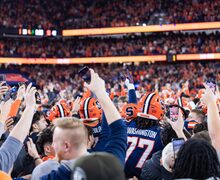How injuries shaped Gabriela Knutson’s backhand, her ‘best shot’
Corey Henry | Staff Photographer
Gabriella Knutson's experiences with wrist pain caused her to work on her backhand.
Gabriela Knutson shook her right hand repeatedly and sat down. At the end of her last two rallies in a March 31 singles match, two forehand shots had sailed into the net.
During the changeover, Knutson went to her bench and mouthed “Ow.” She had cocked her racket back and stepped forward to meet the balls in front of her, but never finished her arm’s rotation. Knutson’s right arm ached after the repeated stresses of one-handed forehands, and she needed her backhand to save the match.
“My backhand was always my shot, always will be,” Knutson said. “That’s the thing I go to.”
Despite Knutson’s loss, her backhand shot helped mitigate her right arm pain. As a child, Knutson immediately favored the backhand and it soon became her “best shot,” she said. When injuries arose from a new forehand technique Knutson learned as a teenager, her backhand became a specialty. As Knutson’s final season with No. 30 Syracuse (13-12, 5-9 Atlantic Coast) winds down, Knutson has used the shot to not only rejuvenate a tennis career that almost ended before college, but also become the top tennis player for SU.
“It’s not like someday I’m going to wake up and my forehand is going to be better than my backhand,” Knutson said. “No matter how much I practice, that’s never going to happen.”
The first time Knutson felt initial pain in her right arm was two days after she returned to the Czech Republic. She was 16 and for the previous month, Knutson worked on her forehand in Miami with one of her mother’s friends, her mother, Ilona Knutson, said.
As her tennis career progressed, Ilona changed Knutson’s forehand grip and motion. While in Miami, Knutson used more wrist motion and exaggerated the finishing turn.
Her first day home, Knutson was ecstatic. “My forehand is much better,” she told her mother. Ilona agreed. But that next day, Knutson complained about right wrist pain. On the third day, it throbbed again and got even worse as the days went by. Knutson “couldn’t even lift a cup of tea,” Ilona said.
Knutson’s muscles hadn’t developed enough for her new form. She quit for a brief time to let her arm heal and became out of shape, Ilona said. It wasn’t the first time — or the last — that an arm injury hindered Knutson. When she was eight, she had her first. Last semester was her third.
“If you see a tennis player’s back, it’s always a little lopsided,” Knutson said, slanting her right shoulder up. “(Tennis players) are very prone to right-hand injuries, especially me. I don’t know why.”

Susie Teuscher | Digital Design Editor
When she resumed play, Knutson relied almost exclusively on her backhand for six months. Occasionally, she mixed in a left-handed forehand shot, but it felt unnatural. If Knutson wanted a chance at college and professional tennis, her forehand form was key, and she would have to use the motion more.
That pain didn’t return during her first three years at SU, at least not to a comparable level, Knutson said. Her forehand shot improved and she began to mix it in more, but Knutson always set up her backhand when possible. That combination helped her rise to No. 4 in the nation as a junior.
Now, Knutson takes an extra step to drop back and execute fading backhand defensive lobs, net-grazing crosscourt winners and short-hopping service returns that help earn points.
“She does take the ball very early, and she’s strong too,” Limam said, “so she generates a lot of pace and power of her backhand shot.”
One week after Knutson resorted to her backhand against NC State, she followed Miami’s Estela Perez-Somarriba’s shot into the left corner. Knutson fired a crosscourt backhand while facing match point. The deep ball was returned high in the air by Perez-Somarriba, and this time, Knutson waited patiently at the net and volleyed a winner.
The SU senior turned and strolled back to the service line, and grimaced as she awaited her next shot. The pain in her forearm forced her to repeatedly shake her hand, but her favorite shot again kept her in it.
“If she gets to a backhand rally,” Ilona said, “I know it’s going to be good.”
Published on April 22, 2019 at 8:44 pm
Contact Andrew: arcrane@syr.edu | @CraneAndrew






